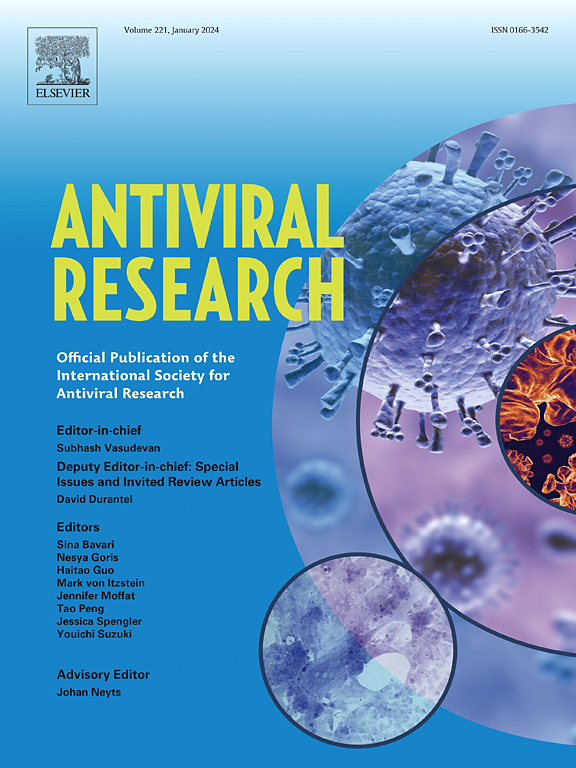用于抗病毒筛选的不含乙型肝炎病毒的 cccDNA 稳定细胞。
IF 4.5
2区 医学
Q1 PHARMACOLOGY & PHARMACY
引用次数: 0
摘要
乙型肝炎病毒(HBV)的共价闭合环状DNA (cccDNA)在病毒感染的肝细胞中作为产生子代病毒的模板。有前景的cccdna靶向抗病毒药物在研发管道中仍然不可获得和不可预测,这使得无菌HBV消除在当前阶段具有挑战性。从丰富的HBV松弛环状DNA (rcDNA)中区分微量cccDNA的主要挑战,实质上阻碍了发现和直接筛选cccDNA靶向药物的努力。rcDNA在序列上与cccDNA几乎相同。因此,需要一种简便的cccDNA细胞培养系统进行高通量药物筛选。在本研究中,我们利用功能互补的概念设计了一种HBV cccDNA自我生成的稳定细胞培养体系,并成功地在HepG2和Huh7细胞中生成了HBV cccDNA高斯荧光素酶报告细胞系。这种设计确保了Gluc信号只在cccDNA形成时表达,从而允许通过发光信号准确而容易地测量cccDNA水平。使用该系统,结合萤火虫荧光素酶报告基因来监测细胞活性,我们在HepG2-HBV-cccDNA/萤火虫细胞系中筛选了2074种药物。选择了4种化合物进行进一步实验,证实了它们的抗hbv作用。因此,该无病毒乙型肝炎cccDNA细胞培养系统为抗hbv药物的高通量筛选提供了一个有价值且便捷的平台。本文章由计算机程序翻译,如有差异,请以英文原文为准。
A hepatitis B virus-free cccDNA-producing stable cell for antiviral screening
The covalently closed circular DNA (cccDNA) of the Hepatitis B virus (HBV) serves as a template for producing progeny viruses in virally infected hepatocytes. Promising cccDNA-targeting antiviral agents remain unavailable and unpredictable in the research and development pipelines, making sterile HBV elimination challenging at the current stage. The major challenge of discriminating trace amounts of cccDNA from the abundant HBV relaxed circular DNA (rcDNA), which is nearly identical to cccDNA in sequence, substantially discourages efforts to discover and directly screen cccDNA-targeting drugs. Therefore, an easy cccDNA cell culture system is required for high-throughput drug screening. In this study, we designed an HBV cccDNA self-generating stable cell culture system using a functional complementary concept and successfully generated an HBV cccDNA Gaussia luciferase reporter cell line in HepG2 and Huh7 cells. This design ensures that the Gluc signal is exclusively expressed upon cccDNA formation, allowing for the accurate and easy measurement of cccDNA levels via luminescent signals. Using this system, in conjunction with a firefly luciferase reporter to monitor cell activity, we screened 2074 drugs in the HepG2-HBV-cccDNA/Firefly cell line. Four compounds were selected for further experimentation and their anti-HBV effects were confirmed. Thus, this virus-free hepatitis B cccDNA cell culture system provides a valuable and convenient platform for the high-throughput screening of anti-HBV drugs.
求助全文
通过发布文献求助,成功后即可免费获取论文全文。
去求助
来源期刊

Antiviral research
医学-病毒学
CiteScore
17.10
自引率
3.90%
发文量
157
审稿时长
34 days
期刊介绍:
Antiviral Research is a journal that focuses on various aspects of controlling viral infections in both humans and animals. It is a platform for publishing research reports, short communications, review articles, and commentaries. The journal covers a wide range of topics including antiviral drugs, antibodies, and host-response modifiers. These topics encompass their synthesis, in vitro and in vivo testing, as well as mechanisms of action. Additionally, the journal also publishes studies on the development of new or improved vaccines against viral infections in humans. It delves into assessing the safety of drugs and vaccines, tracking the evolution of drug or vaccine-resistant viruses, and developing effective countermeasures. Another area of interest includes the identification and validation of new drug targets. The journal further explores laboratory animal models of viral diseases, investigates the pathogenesis of viral diseases, and examines the mechanisms by which viruses avoid host immune responses.
 求助内容:
求助内容: 应助结果提醒方式:
应助结果提醒方式:


